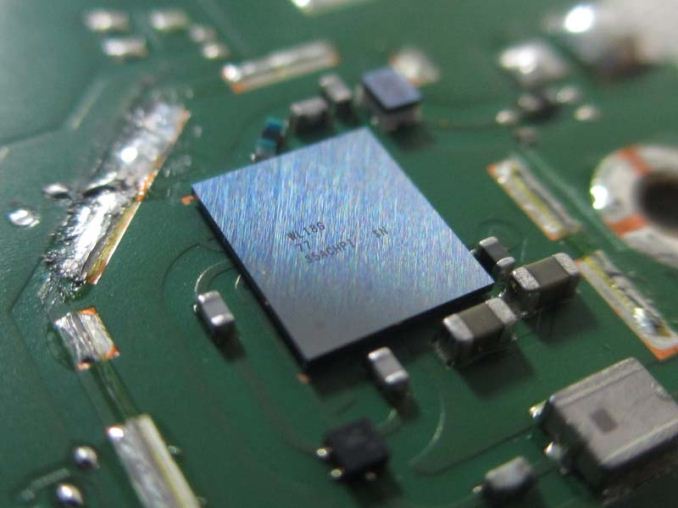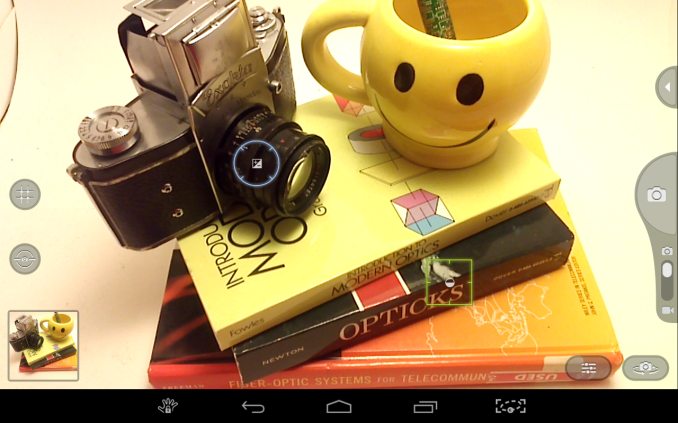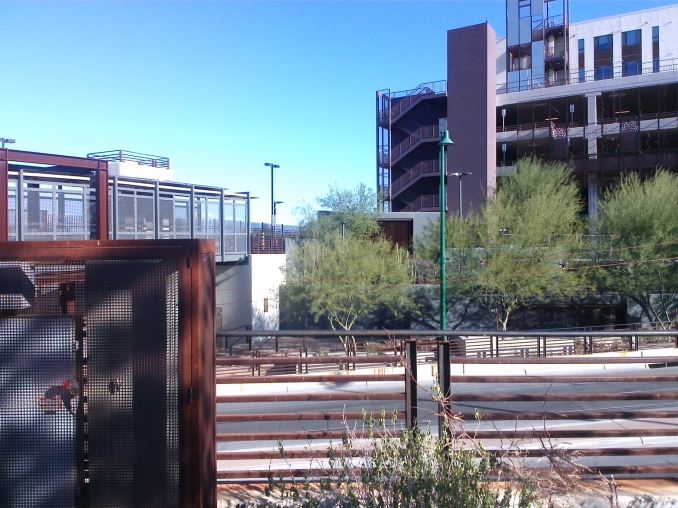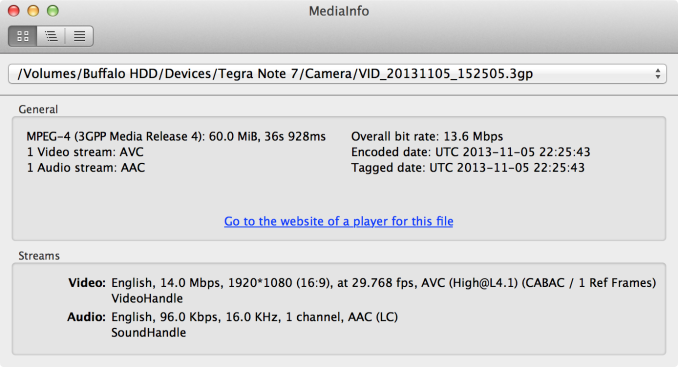NVIDIA Tegra Note 7 Review
by Brian Klug on November 12, 2013 9:01 AM EST- Posted in
- Tablets
- Mobile
- Tegra 4
- NVIDIA
- Tegra Note
WiFi, Camera, Speaker
WiFi
WiFi onboard Tegra Note is courtesy a TI Wilink 8 (WL18xx) series combo which also powers Bluetooth 4.0/LE. I keep hearing that TI has exited the mobile space completely, the reality is that TI continues to have a combo business and makes the PMICs for NVIDIA’s Tegra 4 SoC lineup. In addition the Tegra Note uses a TI GNSS (GPS and GLONASS).
Anyhow Tegra Note includes single stream 2.4 GHz WiFi, 802.11b/g/n, Miracast, and Bluetooth 4.0/LE. I’d love to see 5 GHz be a baseline, but that’s still not the case here, and also has the side effect of making the Tegra Tab incompatible with GameStream.

Throughput on iPerf in our test isn’t bad however among the 2.4 GHz only tests.
Camera
Cameras onboard Tegra Note are 5 MP on the rear, VGA on the front. The rear facing camera CMOS is an OV5690, which is a 1/4“ sensor with 1.4µm pixels, and the front facing camera CMOS is an OV7695 1/13” sensor with 1.75µm pixels. The rear facing camera is F/2.0 with a 4.0 mm focal length according to EXIF, although I’m not sure if I actually believe it, as the field of view looks a lot wider than I’d expect.
Regardless the Tegra Note is our first chance to see Tegra 4’s ISP and something else new, Camera Awesome for Android which is launching with Tegra Note 7. I’ve been complaining about the stock Android camera application for a while, which thankfully the Note 7 doesn’t include. Instead the default camera application is Camera Awesome, whose UI implements a number of the Chimera camera architecture features like tap to track, full resolution burst capture, and in a future release, always-on HDR.
Unfortunately the UI makes the same critical mistake that I see in the stock Android camera, and presents a 16:9 aspect crop of the 4:3 image formed on the sensor. The result is that images have more visible area above and below the preview area shown in the camera application.
Still image quality is actually a lot better than I expected it to be, but looks like a smartphone camera from a year or two ago. It’s adequate enough for a tablet but wouldn’t be competitive in the smartphone space, a few images are a bit hazy as well. I made sure to wipe the cover glass atop the camera between shots, but it’s possible this still contributed to the hazy appearance of a few of the sample shots. Tablets just need to have a camera these days, I’d argue that the one in Tegra Note gets the job done well enough.
Video on the rear facing camera is 1080p30, H.264 High profile with 1 reference frame, at 14 Mbps. I’ve uploaded the video to YouTube for quick viewing and to our servers if you want to see it without a transcode. Oddly enough the file format is .3gp, something I haven’t seen in quite a while. Video has an overexposed appearance and exposure distractingly hunts around quickly quite a lot even in the 40 seconds at the bench location, AF also runs quite a bit. I’m a bit disappointed in overall video quality and hope it improves dramatically with the December update. You can check off the box for video recording on Tegra Note, but not much beyond that.
Speaker
Since the HTC One, front facing speakers are starting to be a regular affair. The Nexus 7 (2013) shipped with stereo speakers, but they fire out the back. I measured the Tegra Note 7 using two songs that I’ve used for comparisons before and the sound data logger I’ve always used. I expected the Tegra Note to come out on top just because of the front facing speakers, oddly enough in terms of loudness the Nexus 7 was slightly ahead, although I suspect the A weighting I’ve always used might give it an edge.
| Speaker Loudness Comparison | ||||
| ASUS Nexus 7 (2013) | EVGA Tegra Note 7 | |||
|
Don't Move (dBA) |
82.11 | 81.92 | ||
|
Feel It All Around (dBA) |
83.44 | 82.90 | ||
The reality is that sound pressure level isn’t everything, it’s absolutely true that the Tegra Note has much more dynamic mids and lows than the Nexus 7 which sounds tinny in comparison. I'd subjectively say that the Tegra Note sounds way better, but is slightly quieter. The Nexus 7 is louder, but it's mostly high frequencies and much more tinny sounding. Tegra Note has speaker protection which runs on the Tegra 4 SoC as opposed to onboard a DSP inside a discrete component or elsewhere like I’ve seen for other products.




















87 Comments
View All Comments
Anonymous Blowhard - Tuesday, November 12, 2013 - link
Didn't see any mention of this; I see it does have Console Mode, but what about the NVIDIA GamePad Mapper software?geniekid - Tuesday, November 12, 2013 - link
The one reason I'd get this over the Nexus 7 is for the microSD slot.Also, I would think the lower resolution would come with some battery savings. I wonder if the inefficiency here lies with the SoC or the display (or something else).
PC Perv - Tuesday, November 12, 2013 - link
What did you use to take pictures? They are horrendous.drexnx - Tuesday, November 12, 2013 - link
feel it all around? lolgeniekid - Tuesday, November 12, 2013 - link
I can't wait for the day when the state of mobile gaming will be such that reviews can focus on actual gameplay benchmarks instead of all the synthetics.Pirks - Tuesday, November 12, 2013 - link
It's already like that on iPad but why would you even be interested in any benchmarks on iPad?Simon42 - Tuesday, November 12, 2013 - link
You said nothing about the sub-par 1gb of ram! Do you have a test that could contrast it with 2gb devices, or at least some subjective impressions? I like to multitask a lot, open 10 tabs and switch from one app to the other, and I highly doubt this thing's superfast CPU can fully compensate for it. I've always felt that my Android devices improved mostly because they went from 512mb and 1gb to 2gb; that with my expectations and with the way I use my devices it has been more beneficial than upgrading to Qualcomm's excellent quad cores.I'm actively looking at something better suited to my needs and with a wider screen than my current 2013 Nexus 7. An SD card to exceed 32gb cheaply - I have lots of PDFs and MP3s - is crucial because any storage becomes slow when full (and now 4.3's TRIM eats battery when it has to work hard) and the stylus implementation looks great, but I won't trade the Nexus' glorious screen, RAM and amazing battery life for some extra speed I hardly need and which is probably only available when RAM is not full.
I was awaiting HP's Slate 8 and I was getting excited about its screen, but it's now confirmed that it too has only 1gb RAM so I'll want to try it but I probably won't buy it unless it multitasks just as well as what I currently have. Does anyone know of any upcoming Tegra 4 device with enough RAM and under 500 grams? I might have to wait for Chinese tablets with that combo and leftover iPad mini screens (Retina or not) or 8.9 inch full HD panels...
Dribble - Tuesday, November 12, 2013 - link
Tend to agree - the 1GB or ram would be a killer for me. Think they would have been better charging $250 for a 2GB ram and a full HD screen. Then you might think nexus is nice but for $20 I get an SD card, stylus better sound and a faster soc. Easy sell.ddriver - Tuesday, November 12, 2013 - link
iphones have 1 gb of ram, so "logically" 1 gb ram is the best amount of ramzodiacsoulmate - Tuesday, November 12, 2013 - link
not on android, but kitkat is opitimized for 512 and less ram? maybe facebook app will stop taking up 80mb of ram...